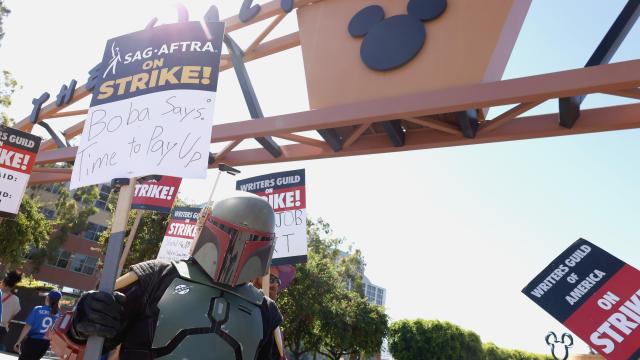The Writers’ Guild of America West has released a 15-page report on the big three streaming services, outlining exactly how far each one has gone to preserve and maintain their monopoly in the space. The three companies at the heart of the report are Disney, Amazon, and Netflix. All three of these streaming services are a part of the Alliance of Motion Picture and Television Producers, which is currently witholding fair contracts from the WGA, and has prompted a strike initiation from the guild.
The full report is well worth reading, but here are some distilled arguments from the WGA that explain how these three companies are taking over the competition without stepping on each other’s toes.
Disney controls the means of production
Through a series of multibillion-dollar acquisitions, Disney has been able to corner its vertical in the market; from Hulu to Fox to Marvel, Disney’s reach keeps expanding. It has been able to shut down smaller competing studios like Fox’s Blue Sky Studios through acquisition. The WGA says that “with each merger, Disney gained market share and leverage against its competitors and its workers, becoming the second-largest distributor of television and online series, the largest employer of television and digital writers, and the second-largest employer of theatrical writers after Netflix.”
Disney also creates shows to exclusively distribute them via Disney+, which has about 50 million fewer subscribers than Amazon or Netflix. As a producer-distributor, the report alleges that “Disney unilaterally pressured creators and other entertainment workers to forego their participation in future licensing revenue.” What this means is that creative talent cannot disagree with the producer on the means of distribution or else they risk getting cut out of their work entirely.
Amazon controls the means of distribution
Amazon was already a household name in media distribution by the time it turned to film. Turning every Amazon Prime member into an Amazon Prime Video subscriber was an easy way for the e-commerce giant to leverage its already sizable subscriber base. Because it has a variety of horizontal integrations, from producing technology like Fire TVs, to producing content, to MGM’s entire catalog, it discourages any new company from attempting to start a business at any part of the production level because they will be competing against the massive company at every stage in the process.
This is even true of larger companies. The WGA reports that Amazon device users were, for a time in 2020, not able to access HBO Max. “The dispute reportedly stemmed from HBO executives’ attempts to retain control of their streaming service over Amazon’s demand to keep HBO Max on Amazon Channels, where Amazon would control the user experience and access to viewership data.”
Additionally, the WGA had to take Amazon to court to force them to release subscriber numbers. While Amazon Prime (and therefore Amazon Prime Video) subscribers currently number in the 200 millions, for years Amazon insisted that the number of domestic subscribers was under 45 million—which meant that it didn’t have to pay residuals in the higher bracket. WGA won this case in 2021 and the National Labor Relations Board demanded Amazon reveal its actual subscriber numbers, leading to increased residuals for writers.
Netflix controls the means of employment
WGA states that Netflix is “is now using its position as the largest streaming service in the world to abuse its leverage as an employer.” According to the WGA, Netflix is currently “the largest employer of screenwriters and the largest employer of writers for online series.” Because of its status as producer-distributor, Netflix locks in creators and makes it difficult if not impossible for creators to take shows off its platform, meaning that creators are often locked into noncompetitive agreements and poor licensing contracts.
Netflix is also working along same lines as the Disney playbook. The WGA report notes that Netflix has acquired numerous other smaller studios as a way to control production, including film production studio Albuquerque Studios, animation studios Scanline VFX and Animal Logic, as well as video game studios Night School Studio, Next Games, and Boss Fight.
The gatekeepers are building their walled gardens
The WGA report notes that not only are these three streaming giants building their walled gardens higher and higher, but other streaming services are emulating them. More and more production companies are also turning into distributors. Besides adapting to the competition, this is also a response to the dissolution of the network anti-monopoly laws known as Fin-Syn.
Fin-Syn (short for Financial Interest and Syndication Rules) was legislation originally passed in 1970 to prevent the “big three” networks—ABC, CBS, and NBC—from monopolizing broadcast television. The Federal Communications Comission did so by passing Fin-Syn, which made it illegal for any network to own or maintain significant financial stake in the programming that they chose to air during prime time. While these rules were controversial and eventually dissolved in 1991, Fin-Syn prevented a second studio system within television.
Now, it seems like the big three streamers might need to come up against a new version of Fin-Syn, if only to prevent the monopolization of art. Television and streaming looks to become the next big battleground, as the WGA alleges that these three gatekeepers are being encouraged by Wall Street investors to buoy their offerings by undercutting workers.
The WGA proposes the following legislative actions, copied verbatim from their executive summary.
- Block further consolidation
- Proactively investigate anti-competitive issues and outcomes
- Increase regulation and oversight in streaming.
The WGA is currently on strike for a fair contract, as the big three streaming companies have proven themselves unwilling—through the AMPTP—to fairly compensate the workers who help make the content that keeps them at the top of their respective industries.
Want more entertainment news? Check out when to expect the latest Marvel, Star Wars, and DC releases, what’s coming to cinemas in Australia this year, and everything streaming this month across all platforms. Check out our dedicated Entertainment tab for more.
